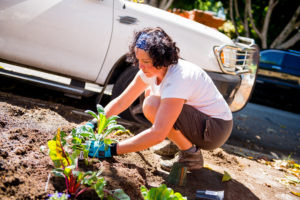HOW TO GROW A STRAWBERRY PATCH
0January 2, 2020 by Hope Gardens

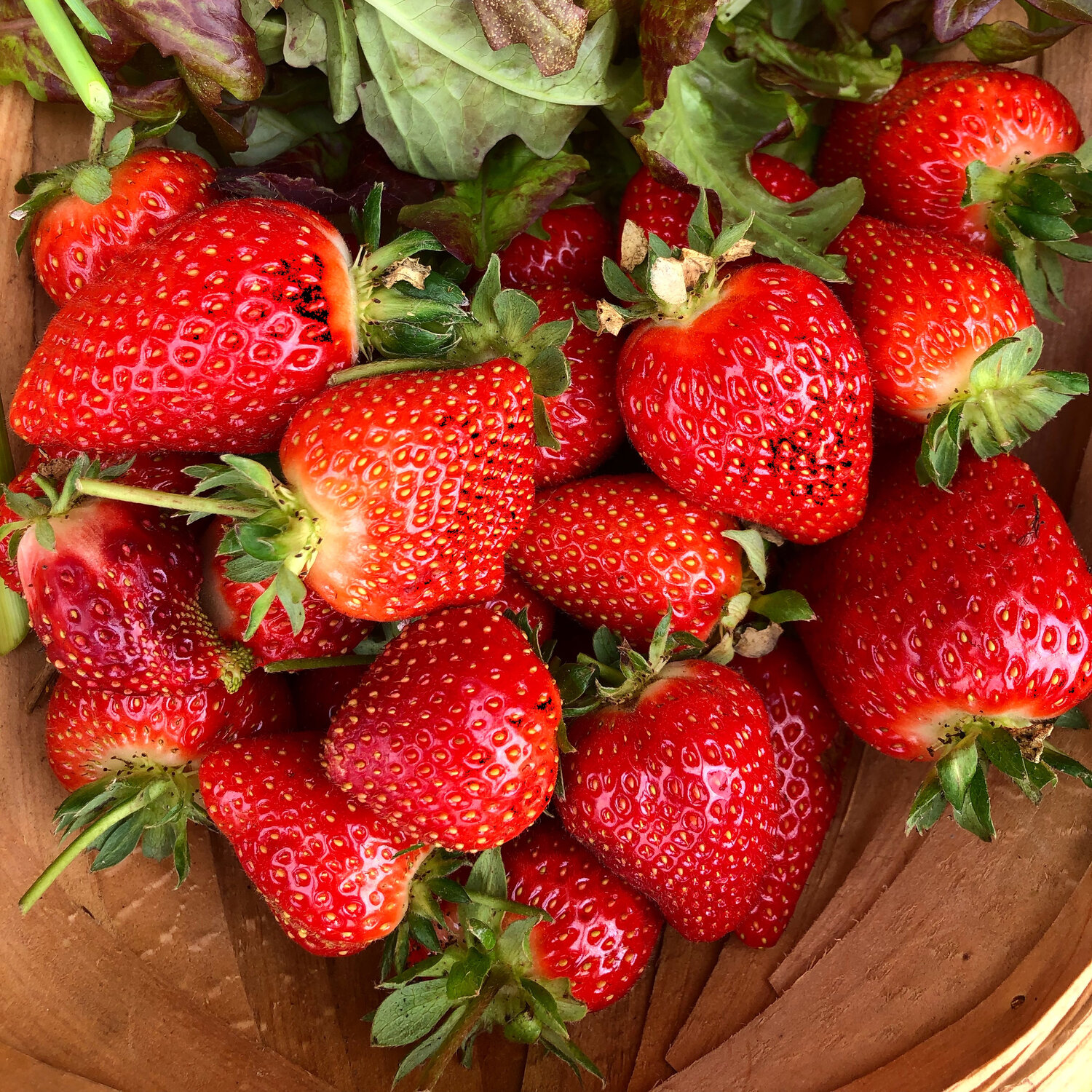
Hello garden warriors! I’ve had my vegetable gardening business for ten years and a plant that has vexed my clients more than most has been, surprisingly, the strawberry. How could a sweet strawberry cause anyone trouble? Well, the number one complaint is that the strawberry plant does not produce enough. Clients wonder: where’s that overflowing pint of giant, perfect strawberries like we find at the grocery store?
Honestly, like many homegrown garden vegetables and fruits, what we have come accustomed to seeing in grocery stores may not match exactly what you end up producing in the home garden. And if you only plant a few strawberry plants here and there, you’re not going to get the harvest of your dreams.

The number one thing I’ve learned about growing strawberries is that they need to be planted en masse. A few plants will not give you a decent yield and these perennial plants need space to roam. In essence, you need a patch.
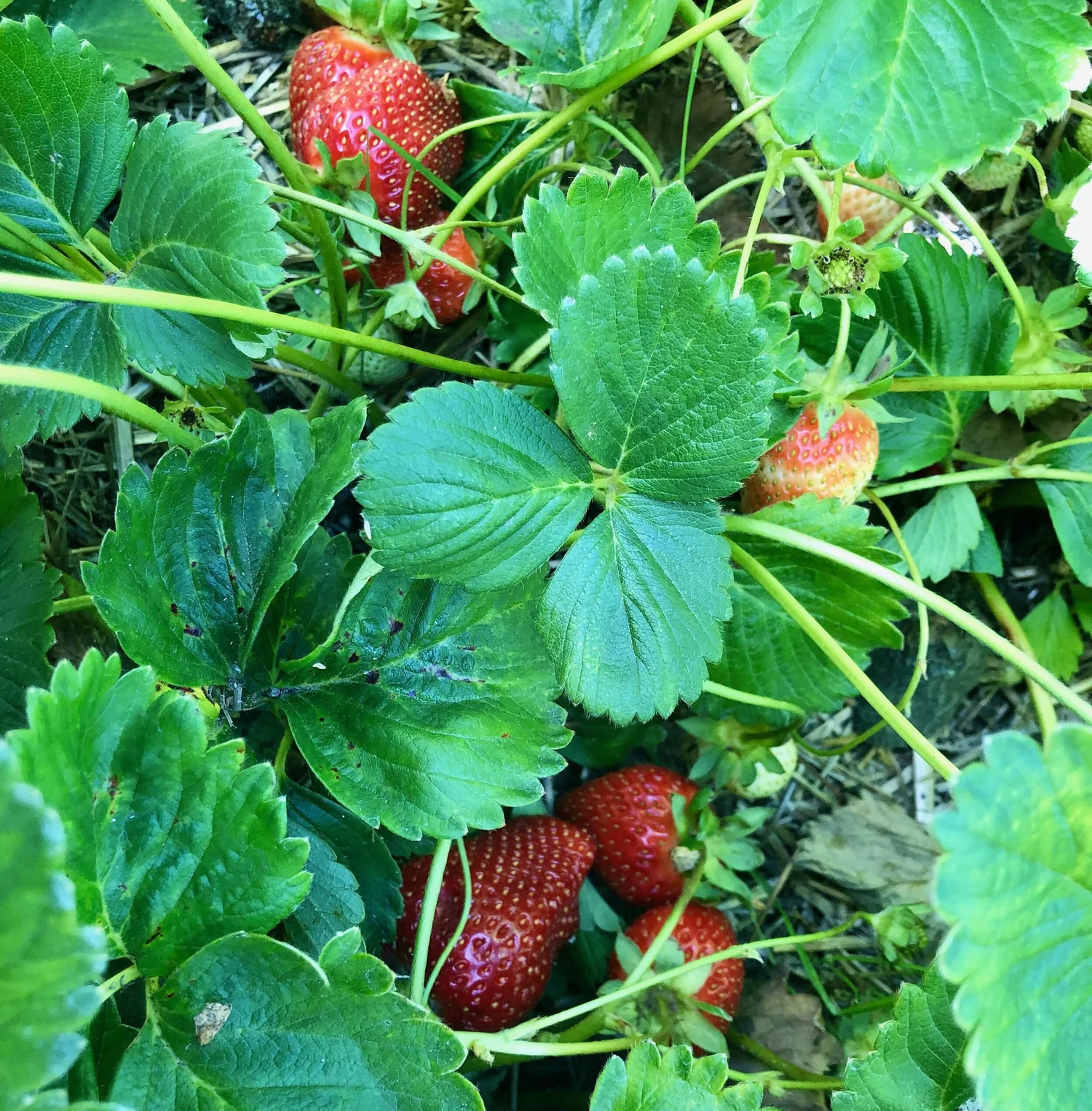
Strawberries thrive when planted by the dozens in close quarters where they don’t compete with other plants – with the exception of our regular garden companions of herbs and flowers. Your strawberry plants will produce runners that turn into new plants and a patch environment allows this reproduction to happen more easily.
VARIETIES
Since you need to install several dozen strawberry plants you should opt for a range of varieties. Strawberries come in “ever-bearing” and “summer-bearing” (sometimes called “June-bearing”) varieties. Ever-bearing berries will give you 2-3 yield times a year (fall, summer, spring) but summer-bearing berries will give you a higher production yield in warm weather starting in June. I include both types in my garden installations.
Ever-bearing strawberry varieties include: Albione, Alpine, Eversweet, Festival and Ozark. Summer- or June-bearing varieties include All-Star, Chandler, Jewel, Mojave and Seascape.
Alpine strawberries look like wild strawberries. The fruits are very small but extremely sweet and tasty, and some even say the plant is prettier. The leaves and fruits sit high above the ground making them easier to harvest. We have had luck growing these types from seed. Check out Baker Creek Heirloom Seeds which has several varieties of Alpine.
STARTING STRAWBERRIES
If growing your strawberries from seed, consider putting your seeds in the freezer for a couple weeks to stratify them.
You can also plant your patch from strawberry seedlings which is how I usually do it. Make sure to purchase them in 6-packs to get the most bang for your buck.
Strawberries need full sun. They will survive in shade as a groundcover but berry production will be low. Plant the strawberry plants 6” apart and completely fill your designated area with the seedlings. You can plant in-ground or in a raised bed or a large container.
Ever-bearing berries do not produce as many runners as summer-bearing berries, so they can be best if using a smaller containers or a strawberry pot. Strawberries can be a beautiful plant in your landscaping and ever-bearing varieties will keep your garden maintenance a little simpler.

When creating your strawberry patch, use a rich potting soil. Strawberries are tolerant of a slightly acidic soil to a balanced pH: somewhere between 5.5-7.5. I use my pH meter quite a bit in the garden and I suggest you get one for your own gardening tool kit. Gardening tools are the best and worth your investment.
The soil should be rich in compost and you can use a potassium-rich fertilizer – often called potash – which will support the plant’s ability to grow fruits. A good tomato fertilizer has the necessary components. Kelp and green sand are natural amendments rich in potassium.
Like all fruits, strawberries come from blossoms. Checking for blossoms is something you should be doing on all your plants.
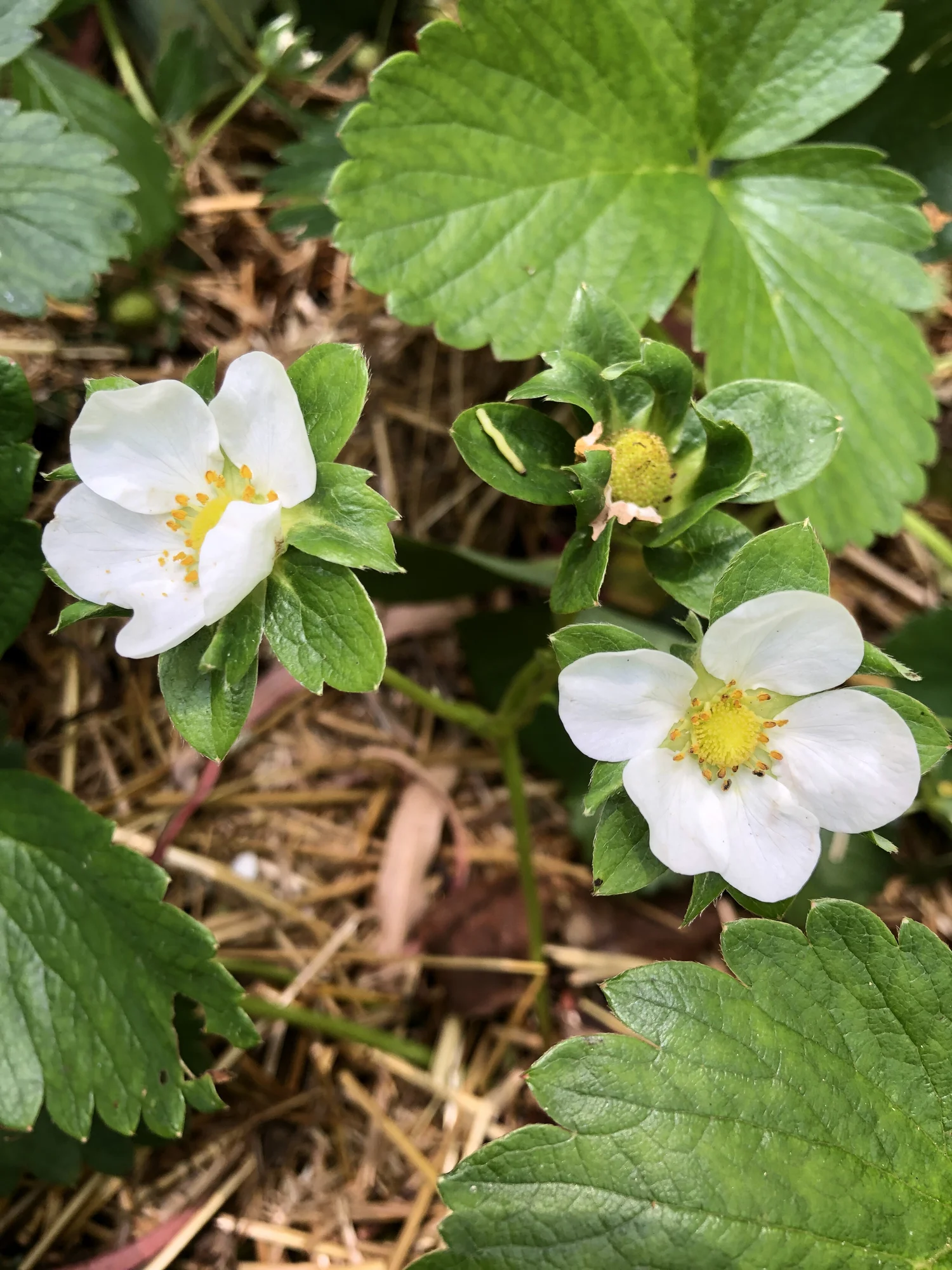
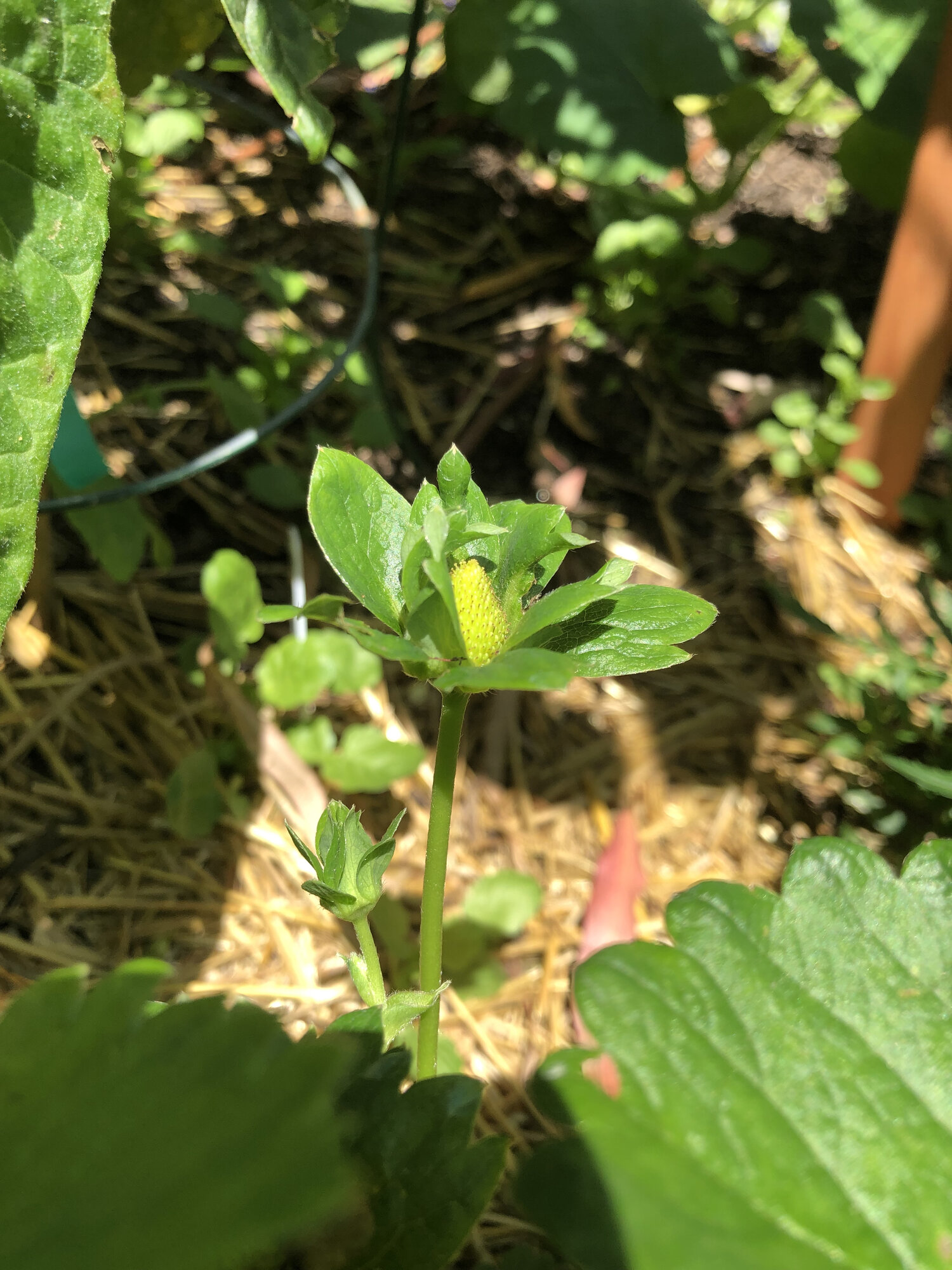
You should also use a liquid seaweed dilution every 2 weeks once flowers appear. You can use the dilution as a root drench meaning your gently pour it on the soil. You can also spray the plant’s leaves with the dilution as a foliar feeding. I buy a big bottle of seaweed concentrate and then dilute it on my own and pour it into empty spray bottles. This is waaaaaaaay cheaper than pre-packaged, immediate-use fertilizer spray bottles.
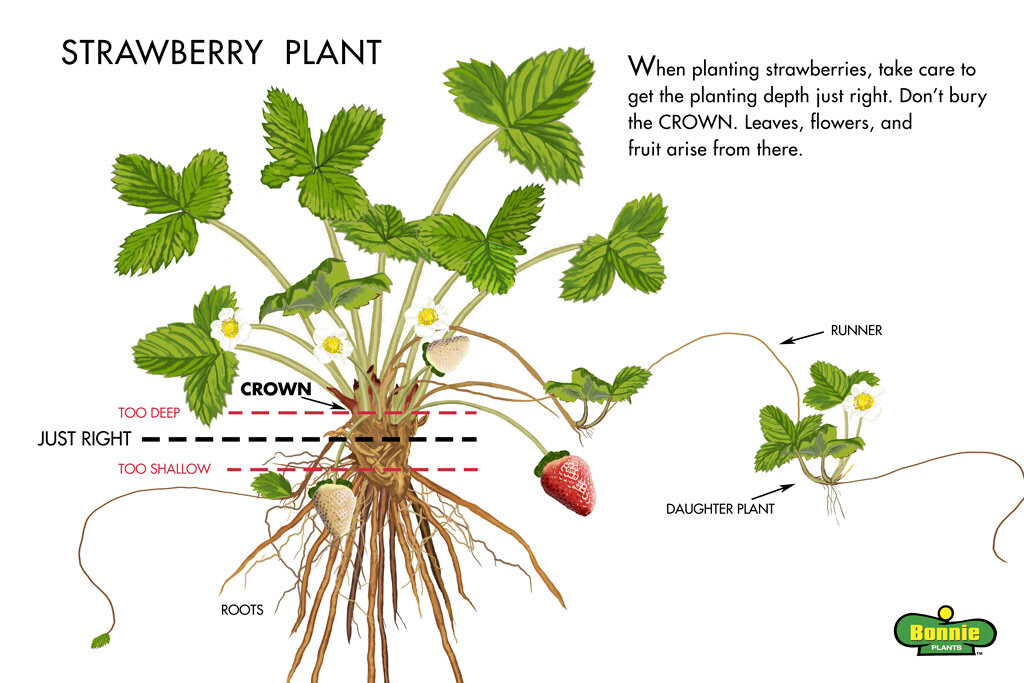
An important part of growing strawberry seedlings is to leave the crown above the soil. The crown is a section of the strawberry plant where the stems attach to the base of the plant. It literally looks like a crown when viewed from the side. If the crown gets buried, the plant can rot.
Plant your strawberries with pungent herbs, like rosemary, thyme, oregano and sage, to repel pests and seasonal flowers to attract pollinators. From experience, I have found strawberries are besties with spinach. When the strawberry plant is chilling and in lower production mode during the winter, spinach takes off. And I’ve observed wonderful growth production from both these plants when grown side by side.
STRAWBERRY MAINTENANCE
In the first season after your berries are planted, you need to sacrifice the first batch of blooms. Cut them off at the head to allow the plants to concentrate their strength on growing a stronger root system instead of putting all their energy into creating fruit. Keep the blooms off until the end of June or beginning of July, then allow the plants to grow one batch of fruit in the fall. Also take off runners for the first year if you are planting by seed. This can take discipline but will get you the fruit production you desire.
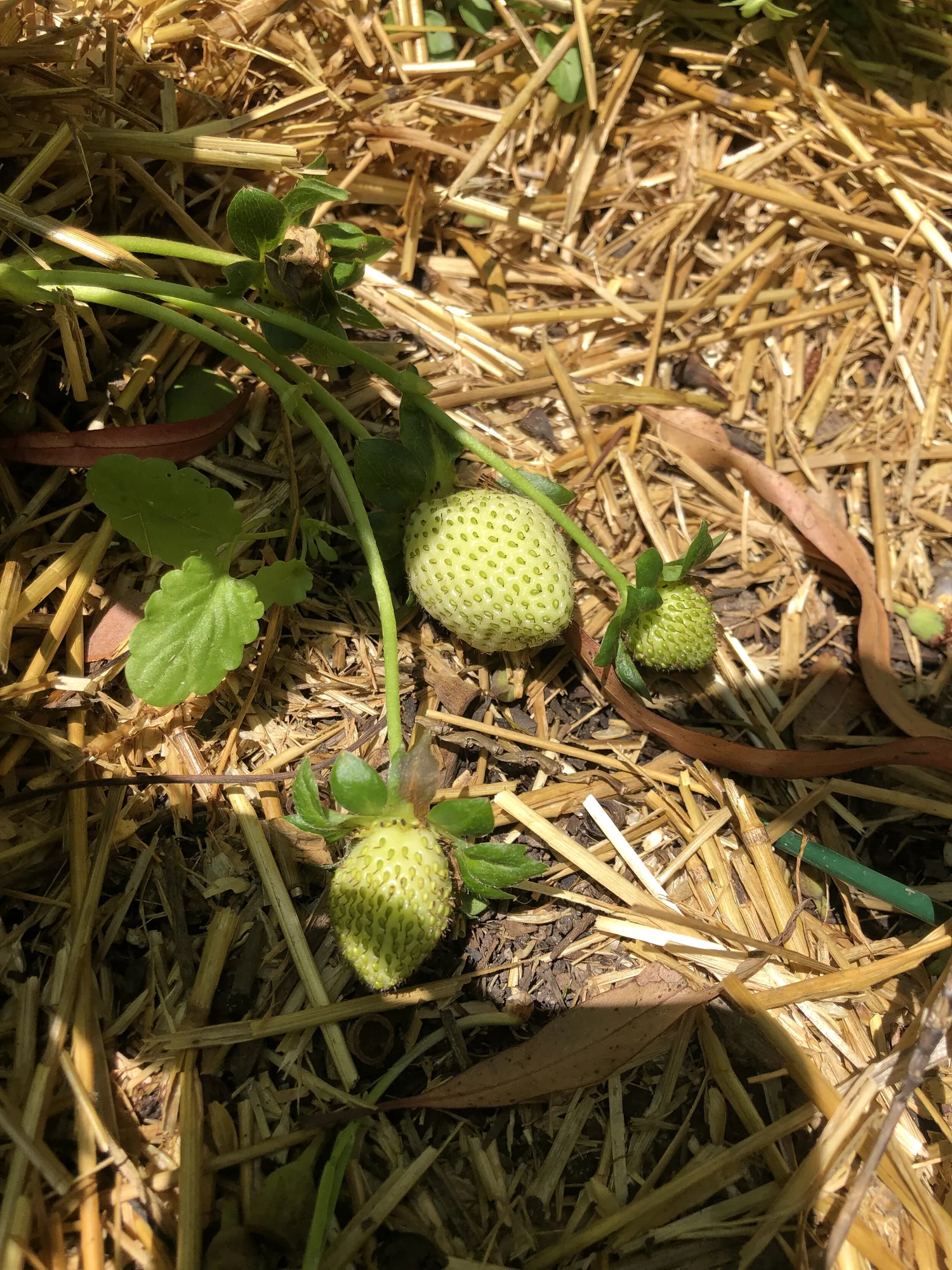
Strawberries need mulched to keep their fruit from rotting on the ground and to keep pests off the fruits. Your strawberry patch will attract slugs, earwigs and pill bugs. Bugs in the soil are fine but we don’t want them snacking on our berries.
Traditionally strawberries are mulched with straw – hence STRAWberries! I do like using straw mulch. You just need to pull out the weeds as they grow but I don’t find the weeds to be overwhelming. You can also use wood chips or shredded leaves as mulch.
Check your strawberries every couple days for ripeness. They can become over-ripe very quickly. Here’s a pic I took of one of my client’s patches to show you the perfect strawberries I picked compared to the rotten ones I found. That’s a lot of missed strawberry goodness!
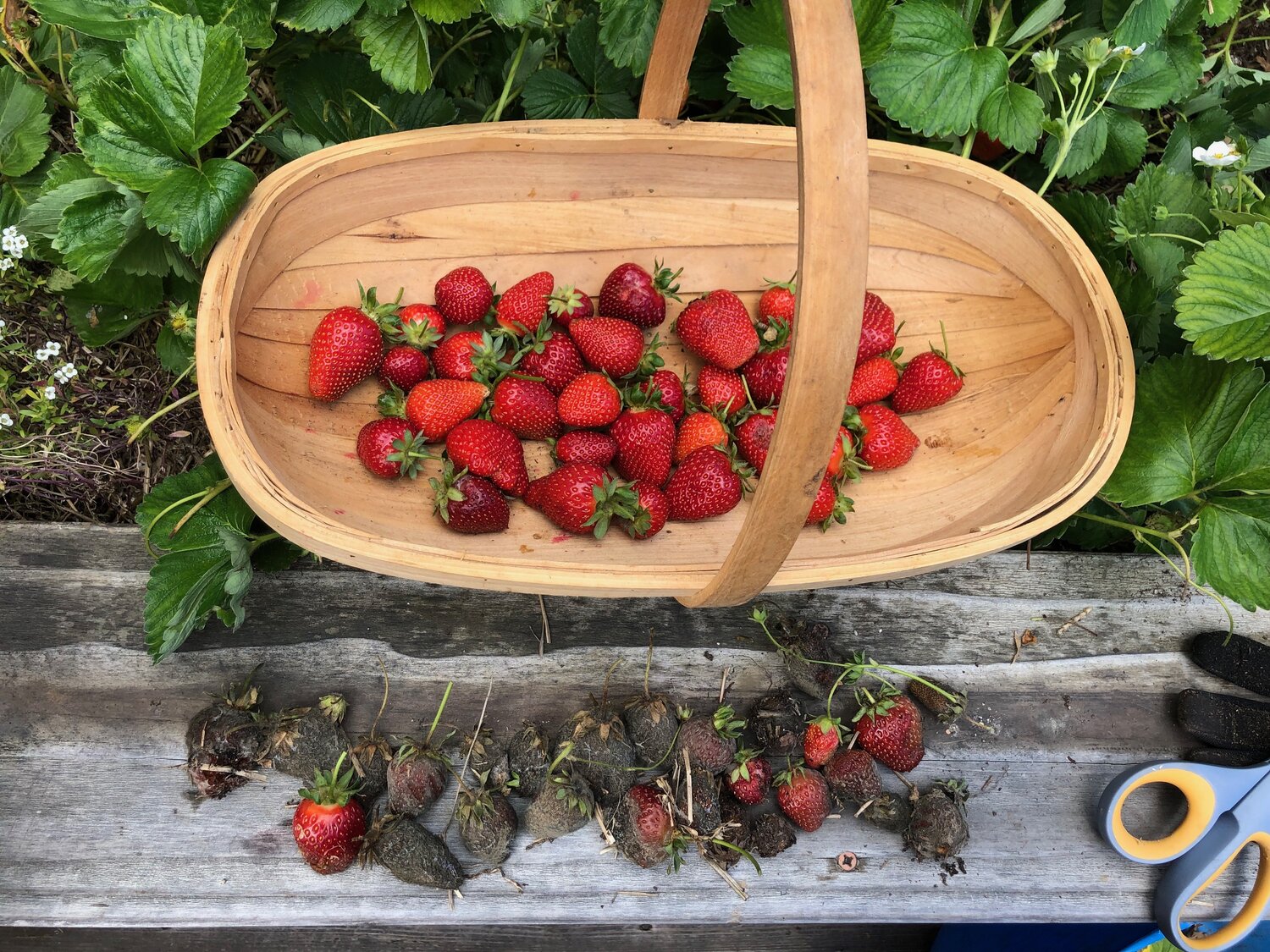
check your berries often!
When checking your strawberries, carefully pick off brown leaves and over-ripe berries or berries that have been nibbled on. You may need to place your berries up on the mulch or turn around the green, un-ripe side of the berries to the sun. Cover the strawberry patch with netting if birds are a problem and use Sluggo to control slugs.
Now let’s talk about runners. Strawberries create runners upon which daughter plants grow and they are crucial to understanding how to grow strawberries.
STRAWBERRY REPRODUCTION
Strawberries are very easy to transplant – so much so strawberries are often sold bare root. And that is seen in how you transplant runners. Strawberry daughter plants can grow roots on the ground and sometimes even grow them in the air.
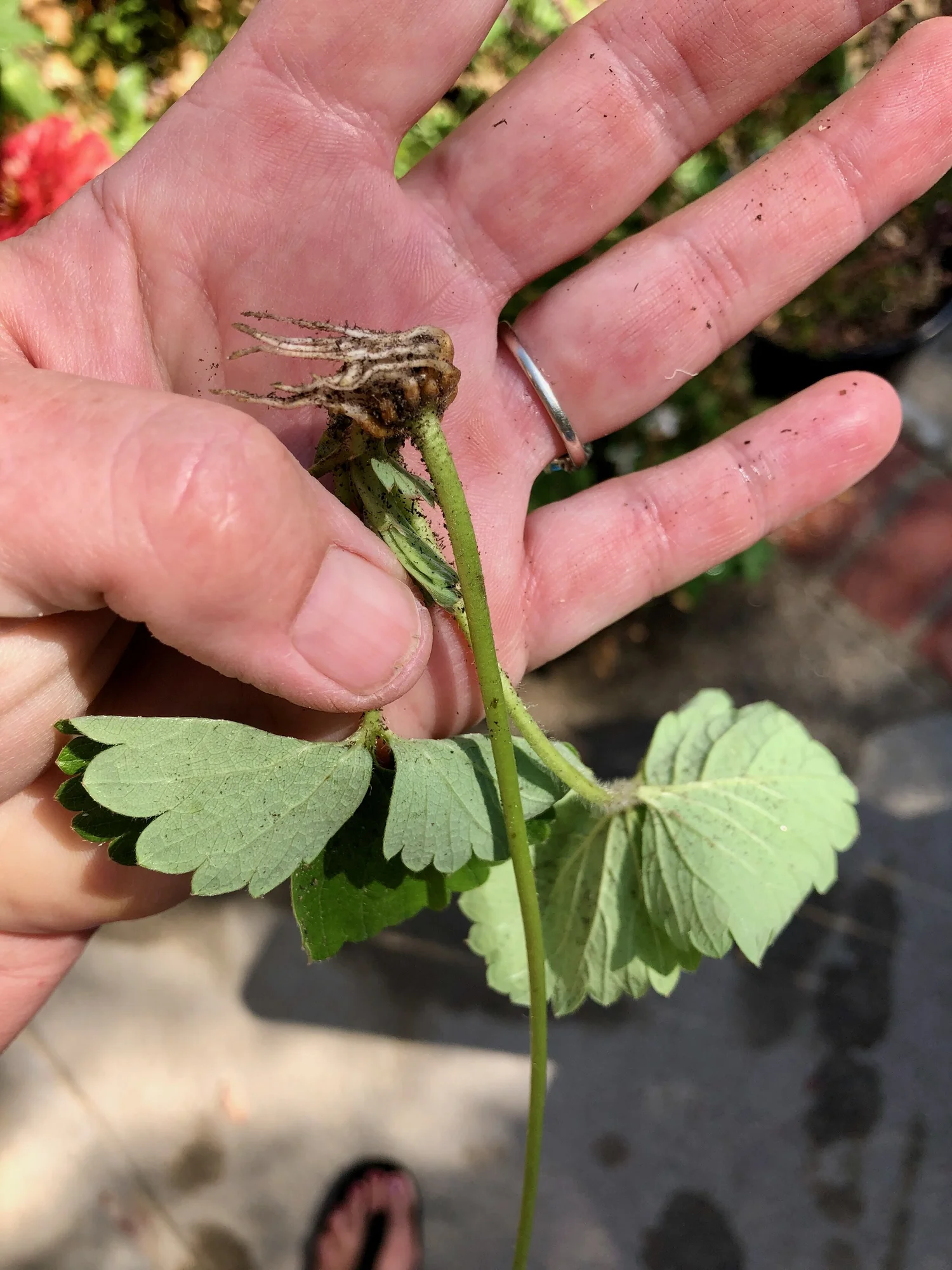
You can pin the daughter to the ground and allow it to grow there or you can cut off the runner plant and start it in a pot or elsewhere in your patch. Leaving runners on the mother plants can drain the energy of your plant. I transplant the bulk of my berries in winter when production is slower but you can remove runners and plant the babies whenever works for you.
At first glance, a strawberry patch can seem like a big mess. Sometimes I need to actually take out all the plants and replant the whole patch. Mother plants peak at 3 years. They can be done producing by year five. So it’s important you get your new baby strawberry plants going.
After I dig out the strawberry plants, I shake off the dirt, trim off the runners and old leaves, and separate them for re-planting.
Then you can transplant the new plants. I put them in a tray or six-pack if I don’t have a place to put them right away. They also make excellent gifts!
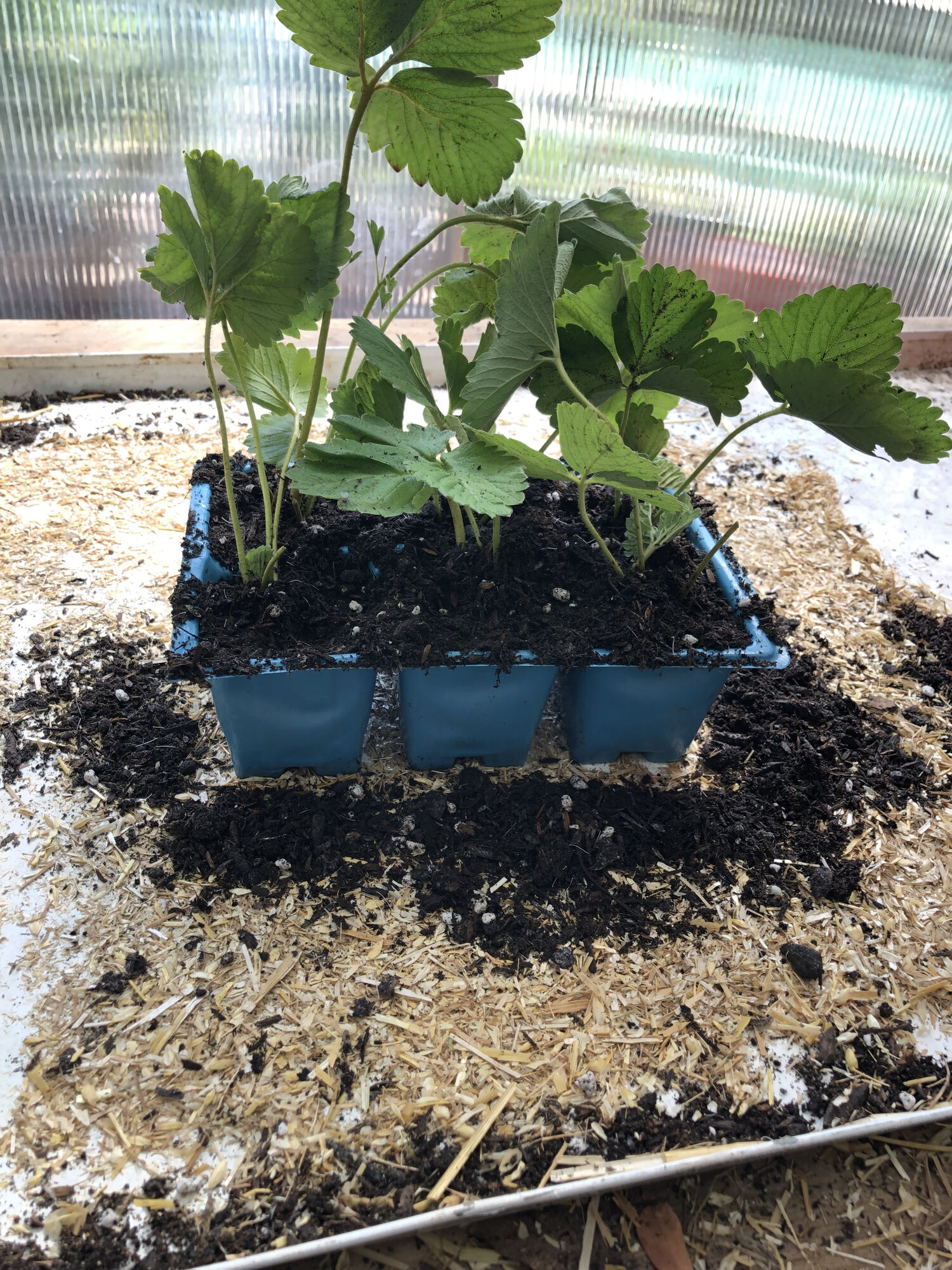
Thank you for reading! I hope you have more insight on these humble fruits. Strawberries excel in a patch and you need larger numbers to promote production. Proper fertilization and maintenance are essential to growing sweet berries. Despite strawberries being thought of as tolerant of shade, these plants needs full sun, regular water and as always, your loving attention. LOVE YOUR PATCH with all your heart and soul. Get a strawberry soul patch!
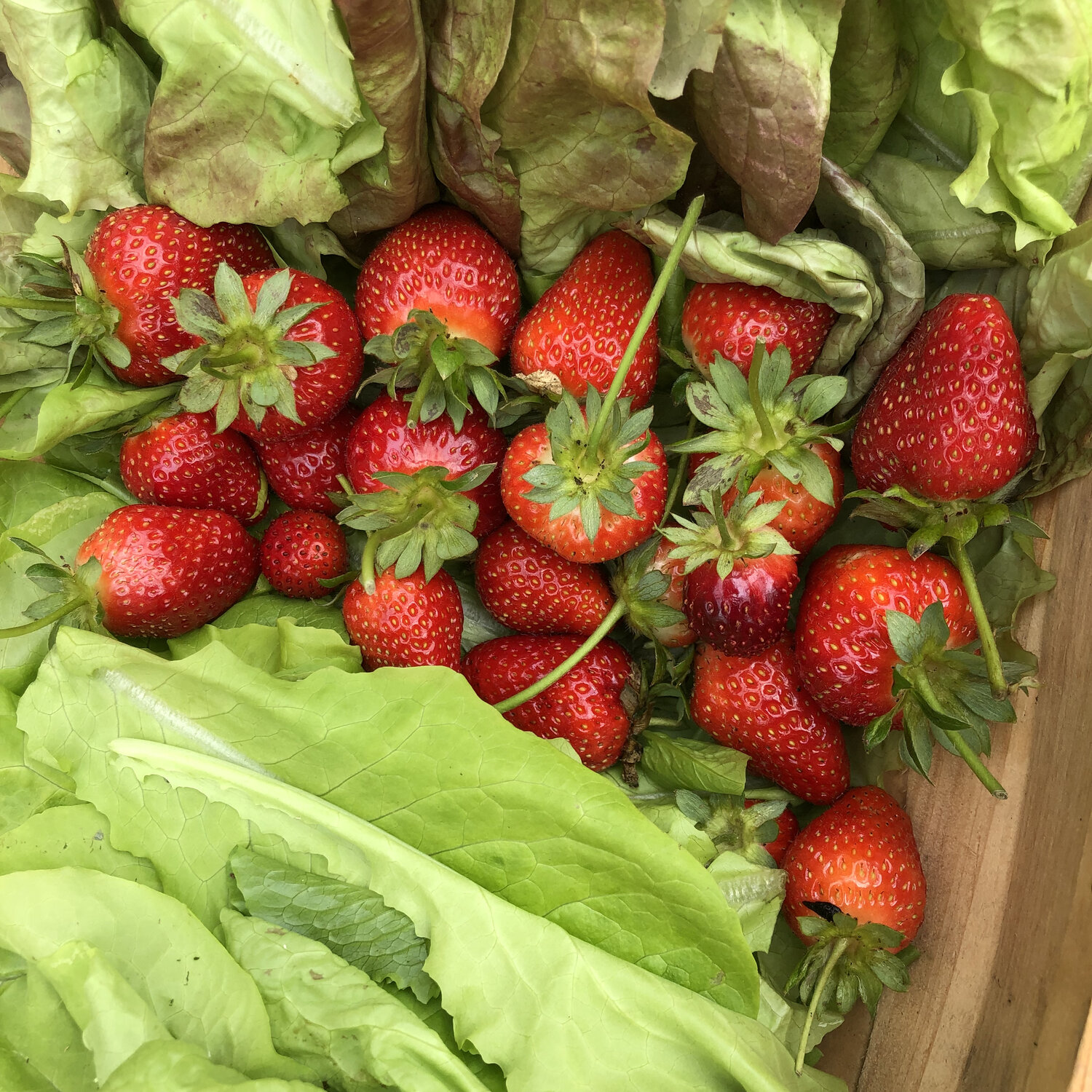
Category DIY Garden Guides, Vegetable gardening | Tags: Garden, strawberry, vegetable beds

